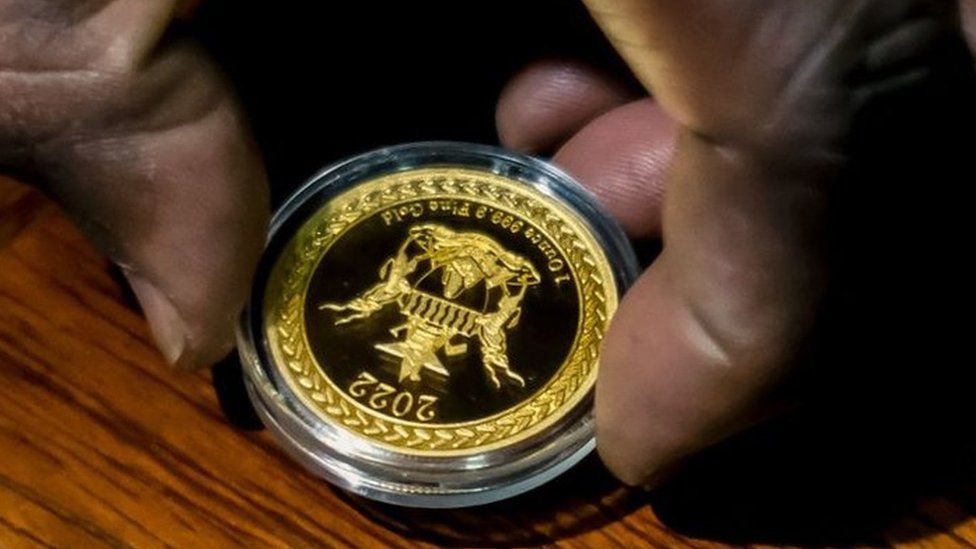Zimbabwe Plans to Stabilize Currency Volatility Using a Gold-Backed Digital Currency

The central bank of Zimbabwe, the Reserve Bank of Zimbabwe (RBZ), has announced its plan to introduce a gold-backed digital currency. This initiative is a response to the current currency volatility in the country. The digital gold token will enable the Zimbabwean dollar to hold its value irrespective of foreign exchange fluctuations with the U.S. dollar.
The fluctuation in the exchange rate between the Zimbabwean dollar and the US dollar has devalued the Zimbabwean dollar. According to data, last year, 1 U.S. dollar was worth 150 Zimbabwean dollars, but now it’s worth 1,000 Zimbabwean dollars. This can be tied to the dual currency operation in the country as a consequence of the COVID-19 pandemic.
The Zimbabwean dollar history
In many ways, the ups and downs of the nation reflect in the turbulent history of the Zimbabwean dollar (ZWD). The Zimbabwean dollar has gone through several revaluations and redenominations due to hyperinflation in the country. It came to a point where the government gave room for the use of foreign currencies for domestic transactions. Which resulted in the Zimbabwean dollar being abandoned in favour of several foreign currencies.
After suffering devaluation for a few years following the hyperinflation, Zimbabwe’s government announced the demonetization of the ZWD in 2009. This allowed for multiple foreign currencies to be used as legal tender in the country. Which include the Botswana pula (BWP), Indian rupee (INR), euro (EUR), U.S. dollar (USD), and South African rand (ZAR). The U.S. dollar, however, has been the most widely used throughout the nation.
A new Zimbabwean dollar
The Reserve Bank of Zimbabwe suspended the multiple currency system in June 2019. It was replaced with the Real Time Gross Settlement (RTGS) Dollar, a new Zimbabwean dollar also known as Zimdollar. However, the Zim dollar was quickly the target of black market speculation, which caused its value to crash, and as a result, the effort has largely failed. In 2020, the COVID-19 pandemic hit the economy so hard that it forced the government to reinstate the use of multiple currencies.
Initially, in 2019, the currency’s black market exchange rate had changed from 1:1 to 1:20 concerning the US dollar. According to Victor Bhoroma, a Harare-based independent economist, the Zimbabwean dollar was going to lose all of its value. The account deficit and weak economy’s weak fundamentals had caused the citizens to lose confidence in the nation’s economy.
According to Galo Mugano, an economics professor at Zimbabwe Ezekiel Guti University, “It’s going to be difficult to maintain the value of the currency. The central bank doesn’t have the reserves to back the value of the currency and has only a month’s import cover at best.” He went on to say that the new currency innovations have failed to act as a store of value. Hence, Zimbabweans and companies are forced to buy U.S. dollars to preserve value.
Current currency volatility
A member of the RBZ’s Monetary Policy Committee (MPC) Persistence Gwanyanya, implied that the festive season influenced currency fluctuation. He said that “the Zimbabwean dollar experienced some temporary shock during the festive season.” This happened after being stable for the better part of the second half of 2022.
Gwanyanya said that “demand for foreign currency normally peaks in the last quarter of the year as businesses restock for the festive season and in preparation for the agriculture season. This period is characterized by a reduced supply of foreign currency following the end of the tobacco season in August, and as the rainy season (November to April) affects production at the mines.”
As everyone was restocking in December, according to Gwanyanya, there was an increase in demand for foreign currency, along with a high demand for agricultural inputs, which are priced in foreign currency.
Hence, the exchange rate volatility. The governor of the RBZ, Dr. John Mangudya, is also aware that the cause of the current volatility is linked to the opening season of tobacco marketing.
A golden solution
Having tried and failed severally with physical currency, the RBZ decided to create digital tokens backed by its gold reserve. The innovation of a digital currency backed by gold in Zimbabwe is an example of how blockchain technology is being applied to solve problems in the real world in Africa. The introduction of the gold token is a follow-up to the Mosi-oa-Tunya coins introduced in 2022.
As earlier mentioned, during the outbreak in 2020, the government allowed individuals to make domestic purchases with foreign currency. But, the U.S. dollar transaction took over the majority of the domestic purchases in the country.
According to the RBZ, the demand for U.S. dollars for domestic transactions was higher than the Zimbabwean dollar. This caused a collapse of the Zimbabwean dollar, leaving the U.S. dollar to account for about 70% of local transactions. To stabilize the currency situation, the RBZ introduced gold coins in July 2022. In a nutshell, the new gold token is the digital representation of the introduced gold coins.
The gold token will serve as a form of electronic money that is backed up by the country’s gold reserve. The RBZ wants holders of the Zimbabwean dollar to exchange their money for the token to protect their finances against volatility. This approach will enable more citizens to patronize the country’s gold industry and curb the level of local currency redundancy.
“What we have noticed is that demand for foreign currency, apart from being driven by the need to import goods and services in Zimbabwe, is also viewed as a store of value, and we are addressing this demand by increasing the number of gold coins in the market,” Mangudya concluded.
Additionally, smaller weights of gold can be easily purchased thanks to the tokenized gold. Gold-backed cryptocurrency can lower entry barriers to the investment class because no physical metal needs to be processed when digital assets are exchanged.
